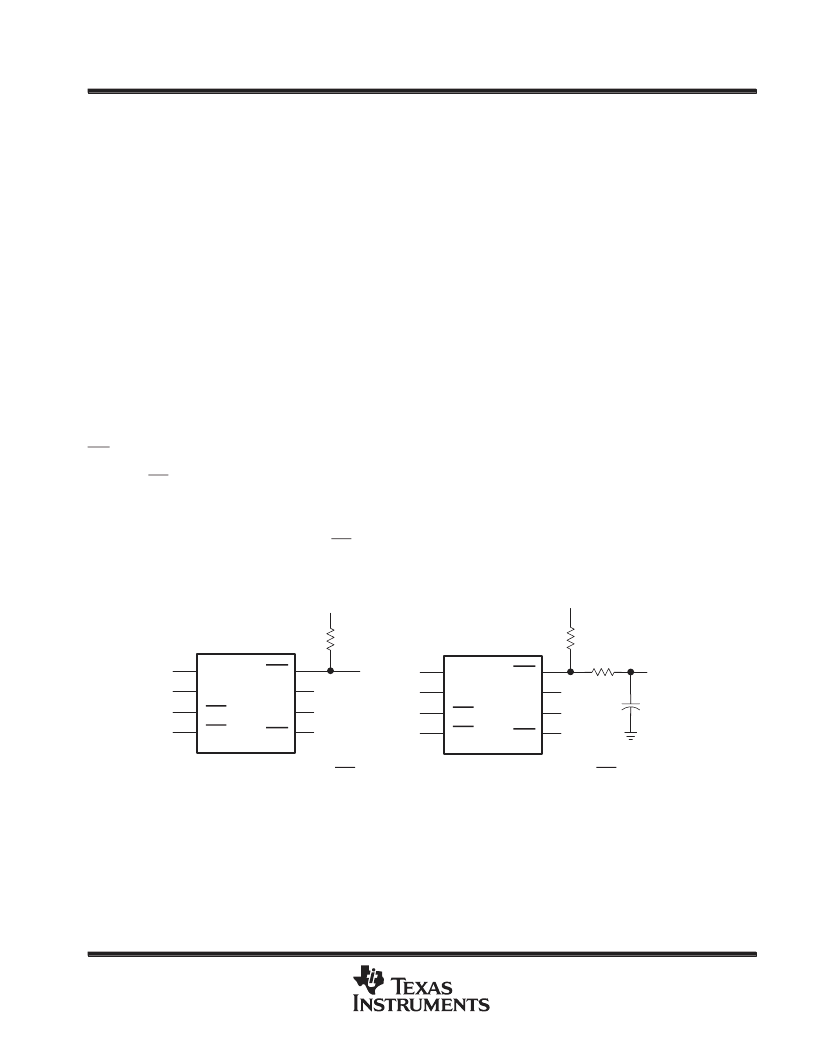- 您現(xiàn)在的位置:買賣IC網(wǎng) > PDF目錄385945 > TPS2052P (Texas Instruments, Inc.) DUAL POWER-DISTRIBUTION SWITCHES PDF資料下載
參數(shù)資料
| 型號: | TPS2052P |
| 廠商: | Texas Instruments, Inc. |
| 英文描述: | DUAL POWER-DISTRIBUTION SWITCHES |
| 中文描述: | 雙電源分配開關(guān) |
| 文件頁數(shù): | 15/24頁 |
| 文件大小: | 430K |
| 代理商: | TPS2052P |

TPS2042, TPS2052
DUAL POWER-DISTRIBUTION SWITCHES
SLVS173A – AUGUST 1998 – REVISED APRIL 1999
15
POST OFFICE BOX 655303
DALLAS, TEXAS 75265
APPLICATION INFORMATION
overcurrent
A sense FET checks for overcurrent conditions. Unlike current-sense resistors, sense FETs do not increase the
series resistance of the current path. When an overcurrent condition is detected, the device maintains a
constant output current and reduces the output voltage accordingly. Complete shutdown occurs only if the fault
is present long enough to activate thermal limiting.
Three possible overload conditions can occur. In the first condition, the output has been shorted before the
device is enabled or before V
I(IN)
has been applied (see Figure 6). The TPS2042 and TPS2052 sense the short
and immediately switch into a constant-current output.
In the second condition, the short occurs while the device is enabled. At the instant the short occurs, very high
currents may flow for a short time before the current-limit circuit can react. After the current-limit circuit has
tripped (reached the overcurrent trip threshhold) the device switches into constant-current mode.
In the third condition, the load has been gradually increased beyond the recommended operating current. The
current is permitted to rise until the current-limit threshold is reached or until the thermal limit of the device is
exceeded (see Figure 7). The TPS2042 and TPS2052 are capable of delivering current up to the current-limit
threshold without damaging the device. Once the threshold has been reached, the device switches into its
constant-current mode.
OC response
The OC open-drain output is asserted (active low) when an overcurrent or overtemperature condition is
encountered. The output will remain asserted until the overcurrent or overtemperature condition is removed.
Connecting a heavy capacitive load to an enabled device can cause momentary false overcurrent reporting from
the inrush current flowing through the device, charging the downstream capacitor. An RC filter of 500
μ
s (see
Figure 30) can be connected to the OC pin to reduce false overcurrent reporting. Using low-ESR electrolytic
capacitors on the output lowers the inrush current flow through the device during hot-plug events by providing
a low impedance energy source, thereby reducing erroneous overcurrent reporting.
GND
IN
EN1
EN2
OC1
OC2
OUT1
OUT2
TPS2042
GND
IN
EN1
EN2
OC1
OC2
OUT1
OUT2
TPS2042
Rpullup
V+
Rfilter
Cfilter
To USB
Controller
V+
Rpullup
Figure 30. Typical Circuit for OC Pin and RC Filter for Damping Inrush OC Responses
相關(guān)PDF資料 |
PDF描述 |
|---|---|
| TPS2100D | VAUX POWER-DISTRIBUTION SWITCHES |
| TPS2100DBV | VAUX POWER-DISTRIBUTION SWITCHES |
| TPS2101DBV | VAUX POWER-DISTRIBUTION SWITCHES |
| TPS2102DBV | VAUX POWER-DISTRIBUTION SWITCHES |
| TPS2103DBV | VAUX POWER-DISTRIBUTION SWITCHES |
相關(guān)代理商/技術(shù)參數(shù) |
參數(shù)描述 |
|---|---|
| TPS2052PE4 | 功能描述:電源開關(guān) IC - USB DUAL HI-SIDE MOSFET RoHS:否 制造商:Micrel 電源電壓-最小:2.7 V 電源電壓-最大:5.5 V 最大工作溫度:+ 85 C 最小工作溫度:- 40 C 封裝 / 箱體:SOIC-8 封裝:Tube |
| TPS2053 | 制造商:Rochester Electronics LLC 功能描述:- Bulk |
| TPS2053A | 制造商:未知廠家 制造商全稱:未知廠家 功能描述:0.7A. 2.7-5.5V Triple (2In/3Out) Hi-Side MOSFET. Fault Report. Act-High Enable |
| TPS2053AD | 功能描述:電源開關(guān) IC - USB Tr .345A 2.7-5.5V Hi RoHS:否 制造商:Micrel 電源電壓-最小:2.7 V 電源電壓-最大:5.5 V 最大工作溫度:+ 85 C 最小工作溫度:- 40 C 封裝 / 箱體:SOIC-8 封裝:Tube |
| TPS2053ADG4 | 功能描述:電源開關(guān) IC - USB DUAL HI-SIDE MOSFET RoHS:否 制造商:Micrel 電源電壓-最小:2.7 V 電源電壓-最大:5.5 V 最大工作溫度:+ 85 C 最小工作溫度:- 40 C 封裝 / 箱體:SOIC-8 封裝:Tube |
發(fā)布緊急采購,3分鐘左右您將得到回復(fù)。